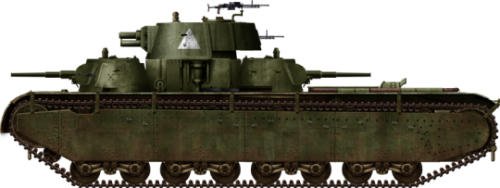The not so mighty Soviet T-35 Heavy Tank,The Soviet T-35 tank was one of those ideas that was great
The not so mighty Soviet T-35 Heavy Tank,The Soviet T-35 tank was one of those ideas that was great in concept but not so great in practical application. During the 1920′s and 1930′s, a short lived popular design concept was the “landship” design, basically the idea was to have an exceptionally large tank with multiple turrets and machine guns. Essentially a land bound gunboat, the landship could engage multiple enemies with it’s many weapons, blasting through and plowing through all opposition with its firepower and armor. The T-35 was the ultimate application of the landship concept. Its main armament was a 76.2mm gun mounted on a 360 degree turret. Two secondary guns of 45mm caliber were mounted on the front and back, and bristling all over the tank were at least six 7.62mm machine guns. At a weight of 45 tons, it was among the heaviest tanks in the world by 1930′s standards, it was also almost 10 meters long, 3.2 meters wide, and 3.4 meters high. Its thickest armor, at the front, was 30mm thick, with the rear and sides being 11mm thick. It took a crew of 11 to man and operate this giant steel behemoth.While the T-35 was certainly an impressive sight, a metal monster with an aura of strength and indestructibility, in reality the T-35 was an inherently flawed design. While having a steel beast bristling with guns may seem badass, in reality each and every gun turret and machine gun port was a weak point in the tank’s armor which could be targeted and exploited. While the T-35 might appear monstrous on the outside, in the inside it was cramped and claustrophobic. On paper the T-35 could manage a speed of 30 KPH, in realistic combat conditions the tank could only manage a slow crawl. In combat, smaller tanks could easily outmaneuver and overwhelm such a slow hulking vehicle. Due to its long length, large width, and overall large size, it was not uncommon for the T-35 to become saddlebagged on hills or stuck in trenches. Turning and maneuvering this gigantic vehicle must have hell for the driver. The greatest failure of the T-35 was its mechanics. Often, the T-35 suffered terrible reliability issues, constantly breaking down and requiring ridiculous amounts of maintenance from its crew. Finally, the T-35 was difficult to produce, using up a lot of resources and work hours to manufacture.Production of the T-35 began in 1935 and ended 1938, only 61 were produced. By 1940 the flaws of the T-35 became apparent to the Soviet Red Army, which planned to relegate their use to training vehicles and parade vehicles, or convert them into self propelled artillery pieces. However in 1941 Germany invaded the Soviet Union, and there was a desperate need for combat vehicles as the war was going badly for the Soviets at the time. The 61 T-35 tanks were assigned to the 67th and 68th tank regiments of the 34th tank division. 90% of those tanks broke down and were scuttled by their own crews before entering combat. Most of the break downs were due to transition problems. One was captured by the Germans and shipped to Germany for testing and examination. I doubt the Germans had a high opinion of their prized Soviet steel turd. The last combat action of T-35 occurred during the Battle of Moscow. Today only one T-35 survives, on display at the Kubinka Tank Museum near Moscow. -- source link
#history#tanks#soviet union#armored warfare#wwii


